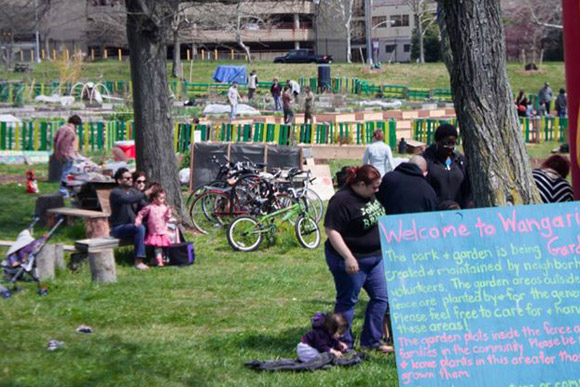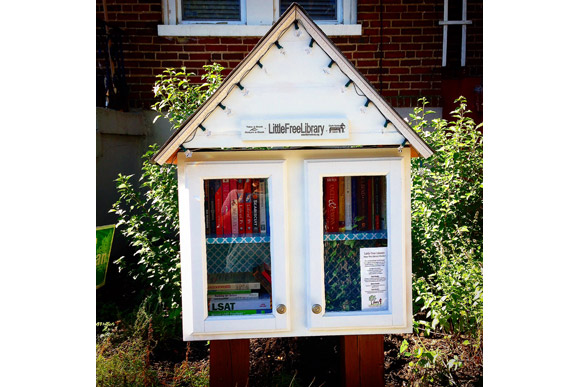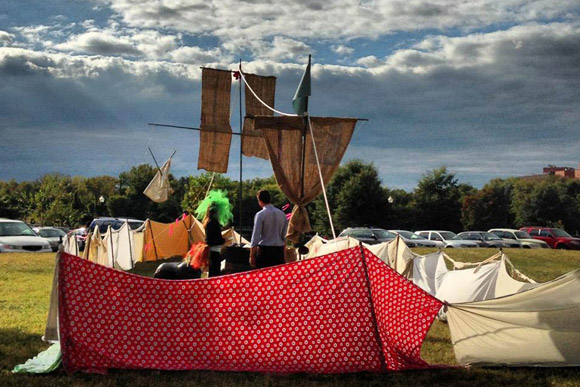Take your street into your own hands with pop-up bike lanes, tiny free libraries, gardens, and more.
In some DC neighborhoods, bike lanes or community gardens sprout up overnight. In others, the pace of change can feel positively glacial.
But waiting around for the city to study or permit a project that could improve your block isn't the only way. (It may be the only
legal way, but we'll get to that.) Clever DIYers have created temporary parks, pop-up bike lanes, or miniature gardens that cheer up their streets, without waiting for the red tape of city bureaucracy.
How D.C.'s gardens grow
 Wangari Gardens in 2013
Wangari Gardens in 2013
The waiting list for a plot at a city-managed garden can be years long, and maybe you just want to brighten up your block. So-called guerrilla gardeners surreptitiously plant seeds on vacant lots, on neglected street corners, and anywhere else they can. Last year, a
group of Franciscan friars planted flowers in an abandoned yard in Park View (you can't make this up).
And then there's Josh Singer. Three years ago, inspired by his job working with community gardens for Casey Trees, he and then-girlfriend Sarah McLaughlin started the long process of beginning a new community garden, the 1.5-acre, 110-plot
Wangari Gardens in Park View. "There was this huge piece of land that wasn't really being used," he says of the space, a 3-acre chunk of land near Washington Hospital in Park View.
"It took us three or four months just to track down who owned the land," Singer says. "It was one of those parcels that wasn't even on the map. It fell through the cracks." After determining that the land was owned by the District Department of Transportation (DDOT), it took another long series of meetings before Singer could get a permit.
Even with all that work, "we were really going to build a small garden, with 10 or 20 plots," he says. Then the community got involved. "Our first few volunteer days were [attended by] way over 100 people." Wangari Gardens, named after Nobel-winning activist Wangari Maathai, now has 110 private plots, public plots maintained by volunteers (and open to anyone), an herb garden and an orchard of 50 fruit trees. Wangari Gardens recently got officially named a 501(c)(3) so it can solicit donations; previously the project was funded by plot membership fees (about half the users of plots pay $50 a year, the other half are given free to needy residents in the area) and Singer's credit card.
The volunteer-run operation is starting to take on a life of its own. They're currently raising funds to create a wheelchair path through their "accessibility" garden for gardeners with mobility issues. Beyond that, the garden offers extensive programming and classes, and of course gives 110 families a place to grow food and just hang out.
"It took a while but we kind of created a structure" for the gardens, Singer says. "Right now, the garden sort of runs itself."
What it is: improving your community by gardening on vacant lots
Who's doing it in D.C.: Everyone from lone "seed bombers" to nonprofits on a mission
Cost: Nearly free to ∞
Walk this way

Frustrated by the speed at which Raleigh, N.C. implemented the wayfinding in its bike and pedestrian plan, student Matt Tomasulo designed his own signs and put them up. "It's a 16 minute walk to Seaboard Station," or "It's 17 minutes by foot to Oakwood Cemetery." Each sign came with a QR code that smartphone users could snap to get directions. The signs came down within a few days, but when he asked the city to implement them as part of a pilot project, the council unanimously approved the measure. Now, you can get your own "Walk Your City" signs from a
site Tomasulo founded.
What it is: encouraging people to discover new parts of their city (or giving tourists some exercise) with DIY navigational aids
Who's doing it in D.C.: No one, yet (that we know of)
Cost: $23 per sign at WalkYourCity.org + shipping
Pop-up bike lanes
Temporary protected bike lanes are having a moment.
According to Streetsblog, "thousands" of Americans have been exposed to temporary protected bike lanes, many of them made by activists on a dime. For even just a day, bike activists use traffic cones, planters, and even paint to mark off a piece of the road for bikes only. Sometimes city officials sanction these lanes, sometimes they're
entirely guerrilla operations. While these actions may be technically illegal, they're also easily undone, a key point. Temporary projects are a way for cities to test out--or for activists to demonstrate--new ideas.
What it is: creating a pop-up bike lane to encourage cyclists and promote bike safety
Who's doing it in D.C.: Nobody (but we do have the Bike Artist, who tags bike lanes with cyclist-friendly messages)
Cost: Depends, but organizers in Minneapolis managed to pull off a demo for $600. You can do it for a lot less if you don't use such attractive plywood planters.
Read with me

Libraries are great "third places"--where community members of all ages and income levels can hang out, read, learn, and use technology. Wouldn't it be great to have a library on every block?
With a
Little Free Library, that's possible. Started five years ago by a Wisconsin man who wanted to pay tribute to his mother, a former schoolteacher, the Little Free Library movement has spread all over the country--including D.C. In its simplest form, a Little Free Library is a "take a book, leave a book" box. But neighbors are finding they're much more than that.
Sally Hobaugh of Edgewood put hers up just a few weeks ago, inspired by ones she saw in Portland, Ore., as well as other yard art that let passersby "interact with the people in the houses." Hers has already begun to draw neighbors together. "I've definitely met some people who I hadn't before," she says. "There's a lot of kids on my block; they'll be outside on my steps looking through the books. I encouraged them to take it and bring it back when they're done," but the kids seem to prefer socializing together near the library.
Hobaugh says her library has already been a resounding success. "The books [that I initially stocked it with] have almost completely turned over, and it is currently stuffed with books, maybe more than it can handle," she says. A friend brought a car-trunk full of more donations, which Hobaugh has been slowly distributing to nearby libraries (of which DC has at least 20) to spread the love around.
But more is better, she says. "There's a couple neighbors who said they would put up [a library] if I helped build them. I want to get one on every block."
What it is: building community through free books
Who's doing it in D.C.: Individuals with private yards, nonprofits, more
Cost: $35 to register your library with LittleFreeLibrary.org, $0+ to build the library. (Hobaugh built hers out of a kitchen cabinet from reuse store Community Forklift that was on sale ($3.71), plus Plexiglas ($14), scrap wood and donated materials.)
Create participatory art
 Scene from Figment 2013
Scene from Figment 2013
Running
FIGMENT DC certainly doesn't fall into the "practically pennies" bucket, but participating in the non-commercial, totally free art festival can be. Producer Patty Simonton organizes the two-day fest (that falls this year on Sept. 27 and 28 in Anacostia Park), but all the programming comes from the community. Think life-size Foosball, a sculpture including flowers made from plastic bottles, bike jousting, and "costume camp," where kids and adults can borrow or take donated costumes. There's hula hooping, dancing, and music, and not a thing for sale. If that sounds a bit familiar, you're right: "It's the daytime version of Burning Man," Simonton says. Submit your own project, or just show up with a kite or bubble wand.
The festival certainly encapsulates the DIY spirit. "It's not backed by any corporation," Simonton says. "This is for the community, by the community."
What it is: Interactive art for everyone
Who's doing it in D.C.: FIGMENT and other worthy orgs
Cost: To run an event, a fair amount. To participate: depends
These ideas run the gamut from totally legal to..not entirely, but remember: Lots of great ideas began in legal gray areas. For years, D.C.'s food trucks operated under a loophole designed for ice cream trucks, which meant they could only pull up to serve customers as long as there was already a line.
PARK(ing) Day, a now-international event where activists turn parking spaces into pop-up parks, began when one design firm in San Francisco went out to a parking space, paid for 2 hours of parking and rolled out a patch of sod. With participation in many cities (including D.C.) now limited to those who get permits beforehand, it's hardly avant-garde, but that's sort of the point. Taking matters into your own hands gets new ideas out there. If they fail? No problem. If they succeed? They'll grow.